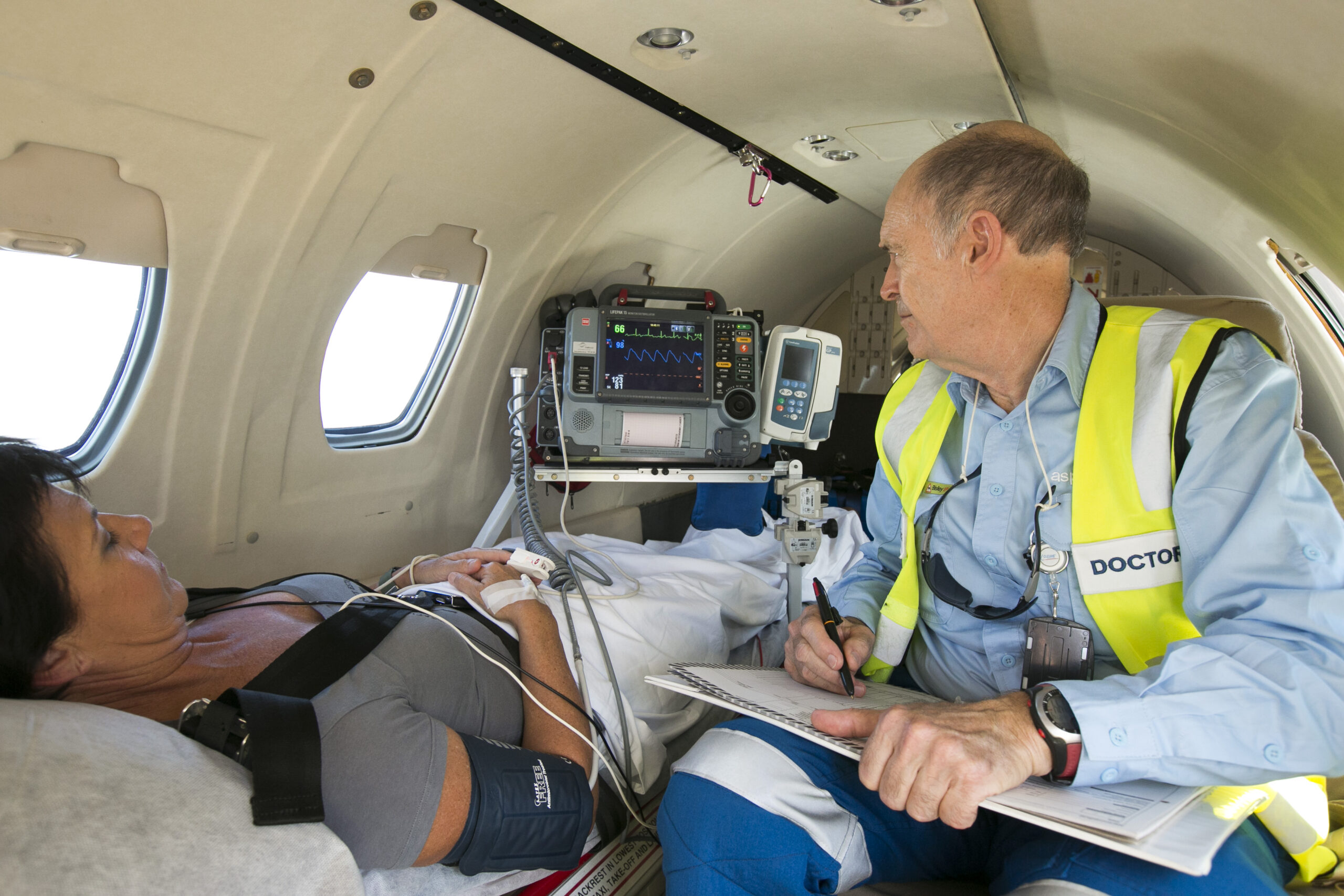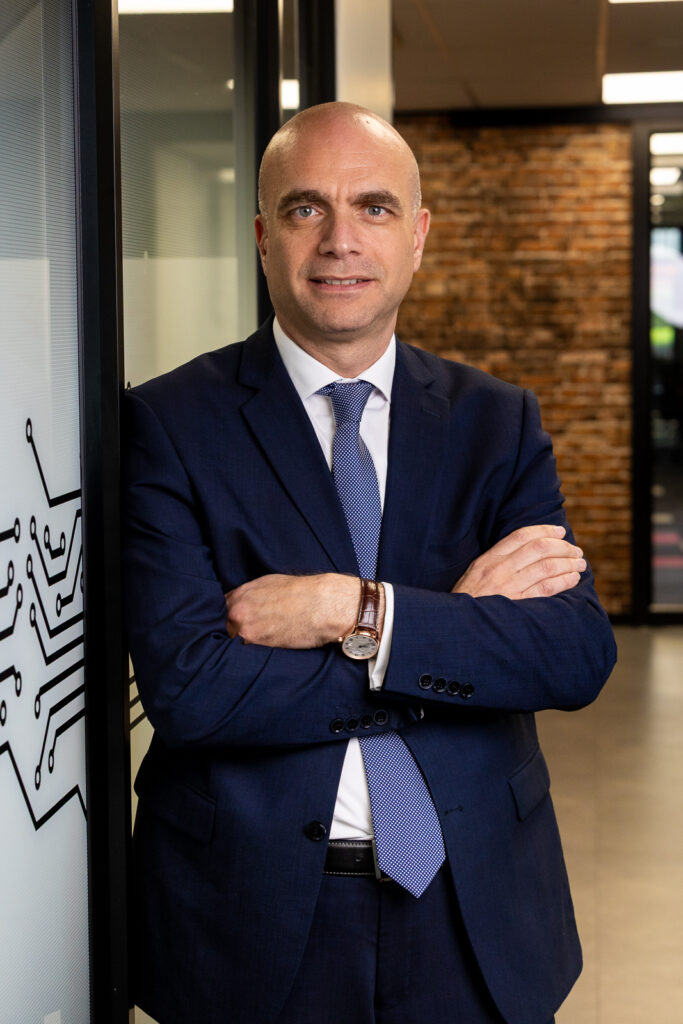Tech Interviews

Vertiv Outlines Data Center Evolution and AI Infrastructure Strategy
Exclusive Interview with Peter Lambrecht, Vice President Sales, EMEA, Vertiv
What specific challenges do clients face in powering and cooling AI infrastructure, and how did you address these at GITEX this year?
At GITEX this year, the focus on artificial intelligence (AI) was unmistakable. Every booth showcased AI-driven solutions running on GPU-powered servers from leading companies like NVIDIA. However, for AI applications to function effectively, the right infrastructure is essential to power and cool these GPUs, ensuring smooth and efficient performance. For us, this highlights our expertise in AI infrastructure, designed to support these platforms optimally.
One of our key focus areas is liquid cooling, as traditional air cooling in data centers is no longer sufficient. With rack densities now reaching 50, 60, and even up to 132 kilowatts per rack, air cooling alone cannot handle the thermal load. Liquid cooling has become critical, efficiently drawing heat away and directing it elsewhere. This core technology, developed with our partner NVIDIA, supports the deployment of GPUs worldwide, and together we provide, market, and deliver these advanced solutions to our clients.
Cooling, however, is only one part of the equation. The shift to AI also requires a comprehensive approach to power management, as AI workloads significantly alter electricity load patterns. Our solutions are designed to meet these power demands, and we have showcased these capabilities at our booth. We’ve been actively engaging with partners and clients to address these challenges as they implement their AI solutions, ensuring that both cooling and power needs are effectively met.
Can you elaborate on your partnership with NVIDIA and how it has evolved over the years?
Our partnership with NVIDIA has grown significantly over the years, and over the past year, it has reached an unprecedented level of collaboration. Both of our CEOs, Jensen Huang of NVIDIA and Giordano Albertazzi of Vertiv communicate regularly, aligning closely on joint development initiatives. Together, we create environments optimized for NVIDIA’s cutting-edge chips, ensuring they have the necessary infrastructure to operate at peak performance.
In a recent joint announcement, both CEOs unveiled new solutions that integrate NVIDIA GPUs with Vertiv’s advanced infrastructure, designed to maximize efficiency and reliability. This collaboration represents the core strength of our partnership, where we have refined reference designs that allow NVIDIA to deploy their GPUs seamlessly and effectively on a global scale.
What current trends do you see in the data center and critical infrastructure market? With many hyperscalers entering the market, what is your perspective on this development?
The data center market is dominated by Hyperscalers, whether through their direct deployments or co-location facilities—two primary models for quickly scaling data center capacity. These Hyperscalers are making substantial investments in infrastructure, fueling competition in this fast-evolving landscape.
The AI race is fully underway, with industry giants all striving toward the same goal. As their infrastructure partner, we are advancing with them, providing the essential support they need to drive this innovation. At the same time, the growth of the cloud sector remains foundational and continues to expand robustly. What we are seeing now is a dual growth trajectory: traditional cloud business growth compounded by the accelerated demand for AI infrastructure.
Trends in data centers reveal a marked increase in power consumption. A few years ago, a five-megawatt data center was considered significant; soon, however, a five-megawatt capacity will fit within a 10×10-meter room as rack density skyrockets, reducing the need for extensive white space but requiring expanded infrastructure areas. Data centers are scaling up to unprecedented sizes, with discussions now involving capacities of 300-400 megawatts, or even gigawatts. Visualizing a gigawatt-sized facility is challenging, yet that is the direction the industry is moving—toward ultra-dense, compacted facilities where every element is intensified, driving an enormous need for power.
As data centers continue to grow, how do you view the sustainability aspect associated with these large facilities?
Today, nearly everyone has a mobile phone in hand, yet data centers—the backbone of our digital lives—often face criticism despite being indispensable to modern society. Data centers are not disappearing; on the contrary, they are set to expand as the pace of digitalization accelerates globally. Power generation remains, and will continue to be, a critical challenge, particularly in regions where resources are limited.
Currently, we see significant advancements in AI infrastructure across Northern Europe. Countries like Sweden, Finland, and Norway benefit from ample hydropower and renewable energy sources, making them well-suited for sustainable AI development. Meanwhile, the Middle East is experiencing a technology boom, backed by its rich energy resources and favorable conditions for large-scale investment in data centers.
There’s also a rising trend toward on-site power generation, with organizations increasingly considering dedicated power stations and micro-grids that tap into renewable or alternative energy sources. In the U.S., for instance, discussions are underway about small, mobile nuclear reactors to support local power needs. Finding sustainable power solutions has become imperative. A sudden surge in electric vehicle usage, for instance, could stress current power supplies dramatically, underscoring the need for substantial changes in our energy landscape.
What support and services does Vertiv offer to its customers? What types of infrastructure investments is Vertiv making in various parts of the world?
At Vertiv, service is arguably the most critical aspect of what we do. Selling a product is only one phase of its lifecycle; the real value lies in our ability to maintain and support that product for the next 10 to 15 years. The availability of highly skilled labor and expertise is essential, as we know that issues will inevitably arise. This is why resilience is a cornerstone of data centers. A strong service infrastructure is vital for addressing challenges promptly when they occur. Just as a car will eventually break down, data center systems too will face difficulties over time. At Vertiv, we have developed an exceptional service framework to ensure that we are always prepared to support our clients.
My philosophy is simple: we don’t sell a product unless we can guarantee the service to support it. When you sell a solution, you’re essentially selling a potential future problem, so ensuring your service capabilities are in place is vital for sustainable growth. This commitment to service is one of our key differentiators in the market.
We are continuously enhancing our core production facilities and making ongoing investments in engineering, research, and development. We are also evaluating our global footprint to optimize production capabilities and meet the growing demand. We are not just focused on the immediate needs of today; we are preparing for the demands that will arise in the next six months, a year, or even two to three years. In this race for capacity, the winner will be the one best positioned with the most scalable and resilient capacity.
What is the future of cooling systems in relation to AI chips, and where do you see this race heading?
While we are not completely moving away from air cooling as it will always play a role in the equation, fully eliminating it would be prohibitively costly. The transition to liquid cooling is a critical step forward. We are already seeing advancements in the liquids used to cool servers, enabling them to absorb higher levels of heat. However, the primary challenge will be addressing the overall densification of data center systems, as more powerful and compact solutions require innovative approaches to heat management.
Our partnerships with industry leaders like NVIDIA and Intel are essential, as they provide us with invaluable, first-hand insights into the development of cutting-edge chips and GPUs. While cooling and power systems might seem straightforward, AI introduces a new layer of complexity that demands forward-thinking solutions. To meet these challenges, we are making significant investments in research and development to support the AI-driven data centers of today and tomorrow. Our commitment to continuous innovation ensures that we remain at the forefront of these critical advancements.
Tech Interviews
How Aspen Medical is Leveraging AI to Deliver Healthcare in Crisis Zones and Remote Regions

Exclusive Interview with Glenn Keys, Founder and Executive Chair, Aspen Medical

Aspen Medical has a strong legacy in humanitarian and military healthcare. How does AI fit into your long-term vision for transforming healthcare delivery, particularly in the UAE and MEA region?
Everything we do at Aspen Medical is health-led and technology-enabled. Our existing systems, governance, training and so on, are about the delivery of high-quality and safe care wherever our clients need us. Technology, including artificial intelligence (AI) enables us to do this. At Aspen Medical, we see AI as an integral part of our strategy to reimagine healthcare access and delivery. In the UAE and broader MEA region, rapid development is creating new demands for precision, resilience and scalability in health systems. AI will enable us to meet those demands in ways that are faster and smarter, for example, embedding AI into remote diagnostics, predictive modelling and digital triage, especially in primary and emergency care settings. In the UAE, where digital transformation is a national priority, we’re aligning with initiatives like the National Strategy for Artificial Intelligence 2031. AI strengthens our capacity to deliver care that is accessible, responsive and tailored to diverse populations.
In humanitarian zones where traditional infrastructure is limited or absent, how can AI-powered healthcare solutions help close the gap in access, diagnostics, and continuity of care?
In regions facing instability, displacement or lacking basic infrastructure, AI can help overcome barriers that have long blocked access to care. Using AI-enabled triage tools, speech recognition and machine translation, language and literacy barriers are reduced whilst guiding patients toward appropriate care pathways. AI technologies that support health workers on the ground – scanning images, analysing vitals and supporting early intervention – can be embedded into mobile devices allowing deployable clinical teams to operate in even the most remote or disconnected settings. Combined with cloud-based health records, AI can ensure continuity of care across humanitarian corridors. It’s not going to be about replacing clinicians; it will be about improving outcomes where they are needed most.
Deployable healthcare is a core pillar of Aspen Medical’s work. How is AI being used to prepare healthcare professionals for unpredictable, high-stress environments such as disaster zones or military operations – and what outcomes have you seen so far?
When lives are on the line, preparation is everything. That’s why we’re working towards integrating AI into the way we train and prepare our deployable healthcare teams. Our goal is to enable clinicians and responders to experience realistic, high-stress environments ranging from natural disasters to military deployments before they ever set foot in the field. By developing AI-powered virtual reality and adaptive learning platforms, we aim to replicate mass casualty incidents, austere conditions, and trauma scenarios. This technology will allow us to track decision-making under pressure and tailor learning in real time. We’re striving to build systems that enhance response times, improve triage accuracy, and boost confidence in the field. Ultimately, we’re working towards using AI not only to strengthen operational readiness but also to reduce burnout and build psychological resilience before deployment.
What role does AI play in enhancing the efficiency and responsiveness of mobile clinics and field hospitals? How is Aspen Medical applying these technologies to support remote workforce health in sectors like oil & gas and humanitarian aid?
AI is beginning to play a supportive role across our mobile clinics and field hospitals, helping teams make better, faster decisions in complex environments. At Aspen Medical, we’re exploring how AI can assist with triage, inventory management, logistics, and reporting, always with clinicians and field experts in control. Early algorithms are helping us analyse trends in patient data and resource use, offering insights that complement, not replace, human judgement. In sectors such as oil and gas, AI tools are being trialed to identify emerging health patterns, like fatigue or heat stress, by combining wearable and clinical data under the supervision of our medical staff. In humanitarian and disaster response settings, these systems are helping improve coordination and data continuity as populations move across regions. Our focus is on using AI responsibly to enhance situational awareness and operational resilience, keeping humans at the centre of every decision that affects care.
Is Aspen Medical collaborating with governments or local health authorities to scale AI-driven solutions across the region as well as globally? What have been the most promising outcomes or lessons from these partnerships?
Yes, we are working directly with health ministries, defence forces and regulators across the UAE and other MEA countries to localise AI solutions that meet national goals. These partnerships are built on co-design: we bring our clinical expertise and global experience, and local authorities bring contextual insight and public health priorities. The most promising outcomes stem from long-term trust. When local systems are involved from the start, adoption increases and impact is sustained.
What would you say are the biggest barriers to AI adoption in healthcare today, and how can companies like Aspen Medical ensure these technologies are deployed ethically and equitably across diverse communities?
Ethical deployment is the challenge and the opportunity. AI is only as effective as the data behind it, and in healthcare, bias or poor-quality data can be dangerous – it is vital that there are strict protocols to validate every AI tool. We prioritise transparency, clinical oversight and community input. We also advocate for inclusive AI, built with diverse datasets that reflect different genders, ethnicities and disease profiles.
Looking ahead, which emerging AI technologies do you believe have the greatest potential to revolutionize healthcare? How do you see Aspen Medical’s role evolving as AI becomes more integrated into healthcare infrastructure?
We believe technologies like generative AI, clinical large language models and AI-assisted imaging will drive the next wave of transformation. Imagine a frontline clinician dictating hands-free notes, while a real-time AI scribe prepares documentation and decision-support summaries. Or an emergency responder receiving instant feedback from an AI model scanning a wound image. Our goal is to leverage federated learning so AI systems can learn from decentralised, privacy-protected data sets. This approach will be critical for delivering safe, compliant, and coordinated care across borders. Our role is to be the connector: bringing together best-in-class technology, robust clinical practice and local insight to deliver safe, smart and scalable healthcare.
Finally, as a founder, what drives your commitment to innovation in healthcare? What legacy do you hope Aspen Medical leaves in the AI healthcare space, especially in regions facing complex and urgent challenges?
Innovation is in Aspen Medical’s DNA. We started by asking: How do we deliver high-quality care where others can’t or won’t go? Today, AI gives us powerful new ways to answer that question. Vitaport, our flagship workplace health and wellbeing platform, developed by Aspen Medical, is the embodiment of that vision. Using agentic AI grounded in clinical governance to deliver personalised care, real-time insights and behaviour-shaping support. But whilst our tools evolve, our purpose remains the same: people are always at the centre. I’m driven by the belief that healthcare must be a force for equity. AI is a tool, not a destination – it helps us extend our reach, deepen our impact, and build systems that are smarter, fairer and more human. The legacy I hope we leave is simple: that we used technology not just to innovate, but to uplift. Especially where the stakes are highest.
Tech Interviews
INCEPTION SHOWCASES THEIR LATEST INNOVATION AT GITEX GLOBAL 2025

Attributed to Vishal Mishra, Director of AI and Software Engineering, Inception, a G42 company
Inception’s presence at GITEX this year focused on bringing enterprise-ready AI solutions to life. Could you walk us through the key innovations being showcased and what makes them stand out in the regional AI landscape?
At GITEX Global 2025, under the theme ‘Authentic Intelligence. Real Impact.’, we showcased our suite of domain-specific and sector-agnostic AI products that are transforming how organizations operate and make decisions. This included (In)Sight, (In)Alpha, (In)Procurement, (In)Business Human Capital, (In)Business Productivity, (In)Business Process, (In)Business Customer Experience, and (In)Media, with a selection of them being demonstrated. These products showed how Inception is helping governments and organizations accelerate transformation, improve efficiency, and generate measurable progress across sectors.
We are also announced a series of strategic partnerships to strengthen our capabilities and global reach and reflect Inception’s commitment to bringing authentic intelligence to life, driving enterprise transformation, and contributing to the UAE’s vision of becoming an AI-native nation.
What distinguishes these innovations in the regional AI landscape is their enterprise readiness and practical impact. Each product has been designed to integrate seamlessly into real operational environments, enabling businesses and government entities to automate complex processes, enhance decision-making, and drive value creation responsibly and transparently. Our focus is on delivering AI that is explainable, compliant, and aligned with national priorities for sustainable digital transformation.
Our presence and partnerships reflect Inception’s commitment to bringing authentic intelligence to life, driving enterprise transformation, and contributing to the UAE’s vision of becoming an AI-native nation.
Inception has evolved rapidly from an AI research hub to a product-first company. Can you give us an overview of your current AI-native products and how they are enabling organizations to automate complex workflows and make smarter decisions?
Inception’s transition from a research-driven institute to a product-first company reflects a clear focus on building practical, enterprise-ready AI that delivers measurable outcomes. Our current portfolio of AI-native products is designed to address specific business and leadership challenges while enabling enterprises to automate complex workflows, generate real-time insights, and make data-driven decisions with confidence.
Our suite of products spans multiple layers of enterprise operations:
- (In)Sight: An AI-powered product for top executives that transforms leadership collaboration by automating meeting workflows, surfacing real-time insights, and integrating seamlessly with Microsoft 365 to drive faster, more confident decision-making.
- (In)Genius: A sophisticated AI-powered insight generation and analysis system designed for automated business strategy research, validation, and reporting
- (In)Alpha: An AI-driven intelligence product that uncovers hidden patterns and insights from vast volumes of unstructured data, enabling more informed investment decisions while reducing biases
- (In)Procurement: An AI-powered platform that transforms supplier discovery, contract management, and sourcing processes with automated workflows and built-in regulatory checks that guarantee 100% compliance
- (In)Media: A next-generation AI media intelligence platform that detects, analyzes, and responds to harmful or misleading narratives in real time.
- (In)Business Process: A no-code AI automation platform that lets enterprises design, deploy, and orchestrate intelligent agents to streamline complex workflows, integrate with existing systems, and ensure secure, scalable process optimization
- (In)Business Productivity: A no-code platform designed to transform the way employees handle daily tasks by integrating speed, intelligence, and automation through a suite of prebuilt, AI-powered workflows that simplify and accelerate work processes
- (In)Business Customer Experience: An AI-powered platform that helps businesses deliver faster, more personalized support across chat, voice, avatar, and web channels through virtual agents and intelligent tools that empower human agents.
Each of these products represent a step toward operationalizing AI across every level of the enterprise. They embody Inception’s mission to leverage authentic intelligence to bring about real impact by enhancing quality decision, operational efficiency, and organizational agility.
Agentic AI is becoming a major theme in enterprise transformation. How does Inception define agentic AI, and what makes it different from traditional chatbots or rule-based systems?
Traditional chatbots or rule-based systems handle tasks by following instructions. They don’t have the ability to interpret, adapt, or anticipate. Instead, they rely on pre-programmed scripts to respond to isolated inputs. Agentic AI, on the other hand, solves problems. It doesn’t wait to be told what to do; it interprets intent, maintains memory across interactions, adjusts to dynamic input, and collaborates with other agents and humans to reach outcomes. It’s essentially an assistant that doesn’t just follow commands but proactively navigates the complexities of enterprise operations.
At Inception, we have a range of products that deploy Agentic AI across different business functions within an organization. (In)Procurement does more than automate contract workflows. It identifies high-performing, sustainable suppliers, accelerates sourcing-to-award cycles, ensures compliance, and drives measurable savings. Our (In)Business Productivity and (In)Business Process products empower teams to deploy no-code AI agents that coordinate workflows, surface knowledge, and make intelligent decisions often faster, more accurately, and at greater scale than human-led systems.
How do you see the adoption of technologies like Agentic AI, sovereign cloud, and domain-specific models influencing the UAE’s innovation and competitiveness over the next few years?
The UAE is entering a new phase of digital maturity where AI is no longer a supporting tool but a national capability. The convergence of Agentic AI, sovereign cloud infrastructure, and domain-specific models is accelerating that transition, creating a foundation for innovation that is secure, scalable, and deeply contextual.
Agentic AI brings autonomy and adaptability to enterprise systems, enabling them to learn and act with minimal intervention. When these systems are deployed within sovereign cloud environments, they operate with trusted national infrastructure that ensures data privacy, compliance, and resilience. Domain-specific models then take this one step further by embedding specialized knowledge that reflects the realities of that respective domain.
By combining Agentic AI capabilities with sovereign infrastructure and purpose-built models, the UAE is demonstrating how nations can build sustainable digital ecosystems that enhance competitiveness, drive productivity, and unlock new opportunities for growth. Inception’s mission is to ensure that this intelligence is not abstract but actionable, bridging the gap between research and real-world impact.
Tech Interviews
From Reactive to Predictive: How AI is Revolutionizing Cybersecurity in the Middle East

Exclusive Interview with Assad Arabi, Regional Managing Director Africa, Mediterranean and CIS, Trend Micro

What are your impressions of GITEX this year?
GITEX has always been an incredible platform, but this year feels different, there’s more energy, more excitement, and a clear focus on meaningful business conversations. The engagement level is impressive, and it’s great to see the region’s digital ecosystem evolving so rapidly.
What is the current state of cybersecurity in the Middle East and Africa?
It’s getting increasingly complex. We’re seeing more AI-driven, sophisticated cyberattacks that are harder to detect and mitigate. Last year alone, Trend Micro detected around 1.35 billion cyber threats in MEA , a staggering figure considering even one major attack can disrupt entire organisation. Globally, cybercrime is projected to cost around USD 10 trillion, which is an enormous economic loss.
This growing threat landscape demands a new approach. Instead of reacting after attacks occur, we’re shifting to a predictive cybersecurity model anticipating threats before they strike. By identifying patterns and alerting organisations in advance, we’re helping them safeguard critical data and infrastructure proactively.
What key innovations is Trend Micro showcasing at GITEX 2025?
This year is special for us. Our flagship Trend Vision One platform, known as the world’s most comprehensive cybersecurity platform, continues to evolve. It integrates multiple security layers from endpoint and server to cloud, network , data, email, IoT, and OT security — into one unified ecosystem.
The latest innovation we’re showcasing is our Agentic SIEM solution, launched just last month. Among the first of its kind globally, it leverages AI to automate rule creation, configurations, and response actions. This will revolutionise how SOC teams operate paving the way for fully autonomous security operations powered by AI.
What emerging trends are shaping 2025?
One of the most concerning trends is the rise of AI-driven threats, especially deepfakes. Attackers can now replicate voices, faces, and data to create what we call “malicious digital twins.” Imagine a video that looks and sounds exactly like you, used to deceive others , it’s a new frontier of cyber risk. We’re actively developing tools to detect and neutralise these threats before they cause harm.
How is Trend Micro leveraging AI to stay ahead of evolving attacks?
AI is central to everything we do. We’ve developed systems that not only detect but quantify cyber risk. For example, organisations receive a numerical cybersecurity score , say, 67 today and 70 tomorrow ,helping them see risk fluctuations in real time and take corrective action.
We’re also creating cybersecurity digital twins, replicating clients’ digital cyber security environment on our platform to safely simulate attacks and test resilience. This enables predictive defence and faster response.
What defines the next generation of cybersecurity?
The next era of cybersecurity will be defined by intelligence and foresight. Having advanced tools isn’t enough; you need actionable threat intelligence. It provides visibility into what’s happening, what could happen, and where your vulnerabilities lie. This shifts cybersecurity from reactive to truly preventive.
How is AI transforming the way organisations predict threats?
At Trend Micro, AI is embedded across our entire ecosystem from endpoint and network protection to cloud, OT, and IoT security. We collect native telemetry data into a central data lake and apply AI models and threat intelligence to correlate anomalies and detect hidden attacks.
Our proprietary Cybertron large language model (LLM) is a breakthrough. It analyses threats contextually, offering insights tailored to each organisation rather than generic alerts. It empowers security teams to identify, prevent, and neutralize threats before they materialize. This advanced level of intelligence was unimaginable just two years ago, and it’s redefining how cybersecurity protection should be perceived .
What are the biggest challenges organisations face in a cloud-native environment?
The biggest hurdle is mindset. Many organisations still use traditional security methods for cloud environments and that simply doesn’t work. Trend Micro offers a complete cloud-native security portfolio covering applications, workloads, containers, storage, and configuration. Our attack surface and exposure management tools continuously assess cloud posture, identify risks, and alert teams before vulnerabilities are exploited.
What impact has the Trend Vision One AI Companion delivered?
The AI Companion acts like our version of ChatGPT for cybersecurity analysts. They can ask questions such as “What does this alert mean?” or “What should I do next?” and receive instant, actionable guidance or even have the system perform those actions automatically. This has dramatically reduced response times and helped close the cybersecurity skills gap, enabling junior analysts to perform at senior levels.
What sets Trend Micro apart from other cybersecurity companies?
As a Japanese company, precision and commitment are part of our DNA. For over 37 years, cybersecurity has been our singular focus. If we enter a segment, it’s because we intend to lead it.
Our leadership is consistently recognised by Gartner, Forrester, and IDC across multiple domains from endpoint and network to IoT and attack surface management. What truly differentiates us is our natively integrated ecosystem, which simplifies management, enhances visibility, increase the protection , and strengthens customer confidence.
-

 Tech News1 year ago
Tech News1 year agoDenodo Bolsters Executive Team by Hiring Christophe Culine as its Chief Revenue Officer
-

 VAR7 months ago
VAR7 months agoMicrosoft Launches New Surface Copilot+ PCs for Business
-

 Tech Interviews2 years ago
Tech Interviews2 years agoNavigating the Cybersecurity Landscape in Hybrid Work Environments
-

 Tech News4 months ago
Tech News4 months agoNothing Launches flagship Nothing Phone (3) and Headphone (1) in theme with the Iconic Museum of the Future in Dubai
-

 Tech News2 years ago
Tech News2 years agoBrighton College Abu Dhabi and Brighton College Al Ain Donate 954 IT Devices in Support of ‘Donate Your Own Device’ Campaign
-

 Editorial12 months ago
Editorial12 months agoCelebrating UAE National Day: A Legacy of Leadership and Technological Innovation
-

 VAR1 year ago
VAR1 year agoSamsung Galaxy Z Fold6 vs Google Pixel 9 Pro Fold: Clash Of The Folding Phenoms
-

 Cover Story9 months ago
Cover Story9 months agoUnifonic Leading the Future of AI-Driven Customer Engagement

























